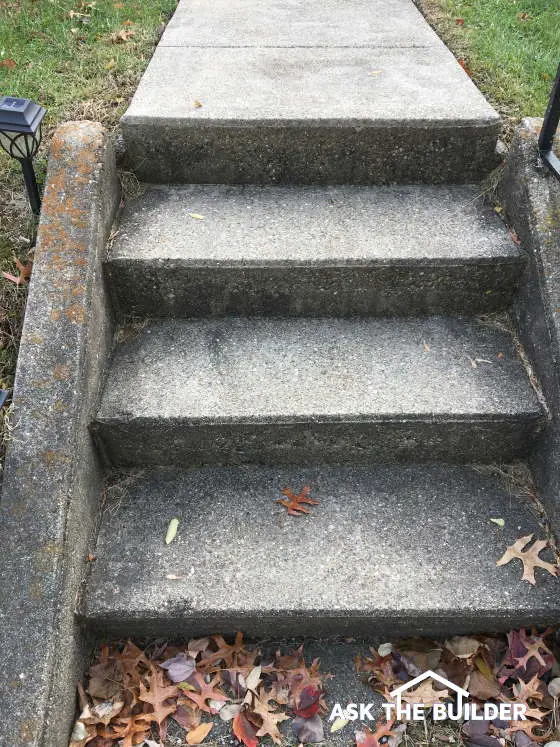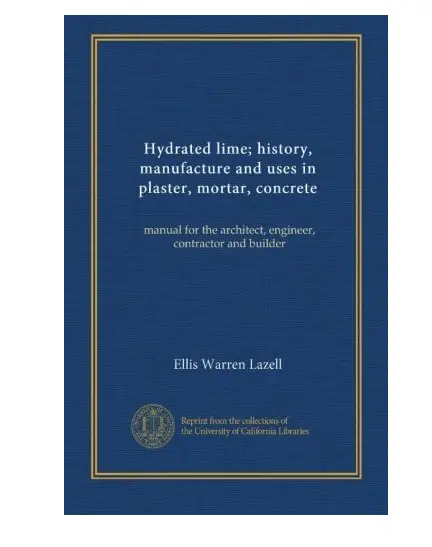Concrete Front Steps Makeover – Use Lime
Concrete Front Steps Makeover - Use Cement Stucco

Concrete Front Steps Makeover - These cast concrete steps are very likely over 100 years old and are in nearly perfect condition. The clue to their age is the presence of the sidewalls. Copyright 2022 Tim Carter
Basic Building Products Last Long
A few days ago, I dedicated one of the new LIVE streaming videos I do each M-F on my YouTube channel at 4 PM Eastern Time to one of the first building products used by man. I’m going back thousands of years and referring to hydrated lime. It’s perhaps one of the most amazing multi-purpose building products ever discovered and then put into widespread use.
A more modern example might be steel. While steel was first invented by those living in India thousands of years ago, the widespread manufacturing of normal steel didn’t start until just before the War of Northern Aggression, often referred to as the Civil War, here in the USA. Steel has countless uses and can be found in tens of thousands of items. Hydrated lime can be found all over the world in countless buildings used both as a mortar and as plaster.
You might wonder, “Tim, what does lime have to do with concrete steps or precast concrete steps?” Well, I told that tale in great detail during my LIVE stream and am happy to share it here.
Modern Concrete Steps Can Fall Apart
Let’s begin by talking about modern concrete that you might have at your home or walk on in your city or town. The Internet is littered with hundreds and thousands of woeful homeowner stories about how their new or newer concrete is crumbling. I’ve got no less than ten older columns about concrete resurfacing on my AsktheBuilder.com website that tell you why this happened. I suggest you read those.
I wish you and I could take a road trip to Cincinnati, Ohio. I’d take you to a few neighborhoods, one being Pleasant Ridge on the east side of town. There I’d be able to show you at least twenty or thirty outside sets of concrete steps that are just like the one in the photo that was provided with this column.
These ancient concrete steps are original in almost all cases and installed when the quaint houses were built in Pleasant Ridge in the early 1900s. How is it that these concrete porch steps, all of them coated with cement stucco I might add, have survived nearly a hundred years and look almost brand new?
That’s a great question and one you should ask each time you see some new product fail and wonder about how an older product that was pushed aside is still in service.
Get FREE and FAST BIDS from local concrete contractors right here.
Why are Old Concrete Steps in Great Shape?
The answer as to why the concrete steps lasted so long is really pretty simple. Back then concrete masons knew that if you added more Portland cement to the concrete mix it made it stronger. This magic gray powder is very similar to hydrated lime. When you mix both with water, you start a chemical reaction where trillions of microscopic crystals start to grow.
These crystals act like modern Velcro. They’re the glue that holds together the sand and stones in the concrete mix. While it would take a chemical analysis to determine if this was true, there’s a very good chance the concrete masons who installed the concrete steps in Pleasant Ridge also added hydrated lime to their mix.
I get excited about hydrated lime for two reasons, one being my college degree in geology. I grew up in Cincinnati, Ohio, and as a youngster had no idea that geologists from all across the world visited my city. It turns out Cincinnati is the world-type section for upper Ordovician sedimentary rocks. If you want to see the best plant and animal fossils of that time period, you come and split apart the limestone rocks interbedded in the shale at all the road cuts in greater Cincinnati.

I own this book. It contains magic formulas to help you make long-lasting concrete and brick mortar. You can order this book now and have it delivered to your home.
I knew limestone was hard and durable as a geology student but I wasn’t aware that dense fine-grained limestone can be heated to create the lime that’s then used as brick mortar, plaster, and a super-adhesive additive in regular concrete. Yes, when you heat up limestone, its chemical composition is CaCO3, you drive off the CO2 and are left with CaO.
Once you grind up this CaO into a powder and then add water, you end up re-creating the limestone. This is why plaster is so hard. This is why true whitewash made from lime and then painted on brick buildings, fences, or other walls lasts for decades. You’re basically painting on or troweling on a thin layer of limestone for goodness sake!
You can now see why it’s a good idea to add hydrated lime to concrete, can’t you? The Portland cement is strong, but why not give it a little boost. Keep in mind the normal MINIMUM standard for exterior concrete exposed to cold temperatures is a six-bag mix. This means six 94-pound bags of Portland cement are in each cubic yard of concrete. It’s probably a better idea to add seven or eight bags to your exterior concrete.
You can bet the old masons building the steps added extra cement and they most likely put in a shovelful or two of hydrated lime. The railroad bridge engineers did the same. This is why you see concrete railroad bridge abutments in your city or town in such great shape after 100, or more, years.
Column 1440